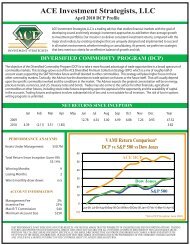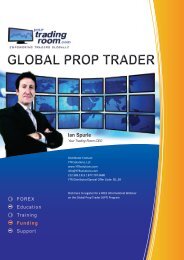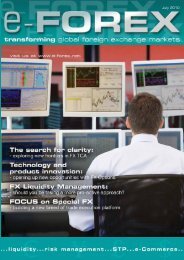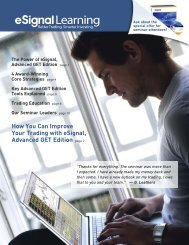Create successful ePaper yourself
Turn your PDF publications into a flip-book with our unique Google optimized e-Paper software.
“We invested quite a bit with our clients to improve<br />
automated processes for risk allocation, sales margin<br />
recognition and allocation, and on the fly risk<br />
calculation and margin calling. The purpose is to allow<br />
our clients to increase their market penetration and<br />
aggressively pursue new clients in an environment with<br />
substantially reduced TCO and operational risk.”<br />
Eddé adds: “As a fundamental consequence, financial<br />
institutions need also to demonstrate that they have a<br />
fully reliable infrastructure able to process massive<br />
volumes. Their infrastructure needs to be robust to<br />
sustain extreme conditions, fast, to provide analysis in<br />
real time and flexible, to implement at low cost evolving<br />
methodologies as standards are shifting in this domain.”<br />
In 2009, Murex leveraged the key features of its<br />
technology to address trends identified over the past<br />
year for banks and asset managers, which had to learn<br />
to work in a more efficient way in a market which is<br />
maturing fast and reinvent a different business model<br />
adapted to new circumstances (less <strong>com</strong>plex<br />
structures, higher capital requirements, lower appetite<br />
for heavy leveraging, etc).<br />
Edde says: “MX.3’s trade modelling allows you to<br />
process any product, whatever its financial <strong>com</strong>plexity,<br />
by considering it as a single processing object. MX.3’s<br />
processing model also supports organisational<br />
<strong>com</strong>plexity, as it automatically mirrors and processes<br />
any type of sales/ traders back-to-back, inter-entity, or<br />
micro-hedge <strong>com</strong>binations.”<br />
“We also invested quite a bit with our client to<br />
improve automated processes for risk allocation,<br />
margin recognition and allocation, and on the fly risk<br />
calculation and margin calling. The purpose is to<br />
allow our clients to increase their market penetration<br />
and aggressively pursue clients in an environment with<br />
substantially reduced TCO and operational risk.”<br />
SaaS<br />
Jiro Okochi, CEO and co-founder of derivative risk<br />
management and hedge accounting solutions provider,<br />
Reval, believes the tools and technologies have been<br />
ahead of the marketplace and end-users are beginning<br />
to finally take better advantage of what already exists.<br />
“For example, Software-as-a-Service (SaaS) has been<br />
available from the FX trading platforms like FXall and<br />
360T and risk vendors like Reval have had thin-client<br />
internet tools for post-trade FX management for<br />
almost a decade,” he says. “This has enabled remote<br />
business units and subsidiaries to enter their exposures<br />
Tracking new developments in currency derivatives processing<br />
Jiro Okochi<br />
“SaaS offerings allow vendors to work more closely together<br />
as well as the ability to use more user-friendly web services.”<br />
for a consolidated view by central treasury for hedging.<br />
Reval also offers scrubbed and integrated market data<br />
that allows for independent pre-trade pricing.”<br />
He says that the biggest choke points arise from<br />
manual processes that are still relied upon, instead of<br />
leveraging the existing technology. “There are still<br />
<strong>com</strong>panies that utilise FX trading platforms for price<br />
discovery but end up still executing over-the-counter<br />
with the dealers,” he adds.<br />
According to Okochi, <strong>com</strong>panies need to use and trust<br />
the newer technologies, like web services, that allow<br />
for more efficient maintenance of interfaces. “As there<br />
is no one-stop service between FX execution,<br />
matching, risk and accounting, there is no choice but<br />
to rely on interfaces, and unfortunately end-users have<br />
had bad experiences with interfaces due to different<br />
technologies that lie on the client side. SaaS offerings<br />
allow vendors to work more closely together as well as<br />
the ability to use more user-friendly web services.”<br />
Okochi says that, in theory, while higher volumes<br />
should drive down processing costs, the current<br />
economic environment is not conducive towards<br />
allowing new entrants into the marketplace that can<br />
increase <strong>com</strong>petition. In addition, potential OTC<br />
derivative reforms will probably drive costs higher for<br />
end-users, either through margining or clearing or<br />
other fees, and the jury is still out on what the<br />
regulators will decide for FX derivatives.<br />
january 2010 e-FOREX | 65










